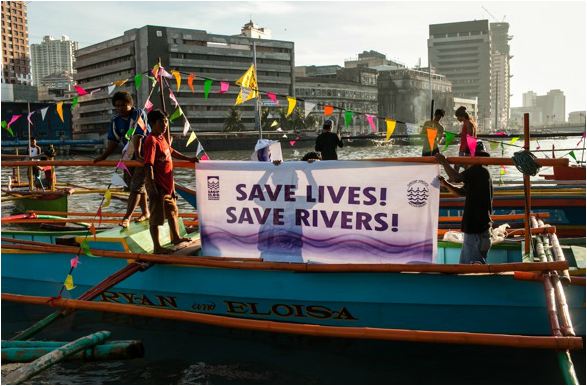Text By XIANNE S. ARCANGEL, Photos by MARIO IGNACIO IV
RESTORING the Pasig River back to life might be a daunting task, but the Sagip Ilog Pilipinas Movement (SIPM) believes young and old boy scouts and fraternity members are up for the challenge.
SIPM marked the 19th Annual Pasig River Fluvial Parade Friday with the presentation of its designated Scouts for the Rivers, composed of all members of the Boy Scouts of the Philippines (BSP) and the Alpha Phi Omega (APO) Fraternity.
The partnership was formalized with the signing of a Memorandum of Understanding (MOU) by the representatives of SIPM, BSP, APO and the Department of Environment and Natural Resources, through its River Basin Control Office (DENR-RBCO).
As river scouts, BSP and APO will be tasked to protect the country’s rivers by spearheading cleaning and rehabilitation programs, as well as launching information campaigns to promote the importance of having clean rivers.
SIPM Executive Director Myrna Jimenez said that while the BSP has long been involved in environmental causes, it is only now that boy scouts are being tapped to embrace a specific cause.
She added that the partnership with the BSP was a “practical option” since SIPM can already mobilize the members to action.
“With this partnership, we don’t have to reinvent an organization just to show that we have the support of a lot of sectors,” she said. “We can tell the BSP to just include caring for the rivers as one of their advocacies and we already have new supporters.”
APO Scouting Commission Chair Tony Dimaano said their members are qualified to become river scouts because APO is a scouting fraternity.
He said: “APO was founded on the ideals of scouting. In fact, all our founders were scouts… (This partnership) will allow us, the fraternity’s older members, to return to our scouting roots.”
Dimaano added that the fraternity’s first project as river scouts will be the rehabilitation of the Sto. Tomas River in Zambales.
APO has become an advocate for the protection of local rivers since it joined forces with SIPM in 2011. In December last year, members of the fraternity’s ETA chapter at the University of the Philippines in Diliman dedicated their annual Oblation Run to the rehabilitation of the country’s waterways.
Representatives from the Metro Manila Development Authority (MMDA), DENR-RBCO and the Philippine Coast Guard joined more than 200 participants at the Plaza Mexico Pasig River ferry service station in Intramuros, Manila as early as 6 a.m. to witness the festivities and procession of colorful boats and floats along Pasig River.
Some boy scouts and MMDA personnel took the three-hour boat ride to the Makati City Garden Park in Guadalupe, where the signing of the MOU was held.
Severino Galindo, SIPM chairman, said this year’s parade, which centered on the theme “Katiyakan sa Tubig, Katiyakan sa Pagkain!” was held in April instead of its usual March schedule as a prelude to the celebration of International Earth Day.
Jimenez said SIPM—formerly known as Sagip Pasig Movement (SPM)—continues to hold the parade to raise awareness about the importance of having clean rivers and waterways.
The sudden population increase in Metro Manila and the rapid urbanization of the region transformed the Pasig River, which was once compared to the Grand Canal of Venice, into a murky, waste-filled waterway.
Research from the World Health Organization show that at present, only six species of fish and two types of plants can thrive in the heavily polluted waters of Pasig — a far cry from the days when it used to serve as a habitat for 25 varieties of fishes and 13 different types of aquatic plants.
The efforts of various government agencies and nongovernment organizations to rehabilitate the biologically dead river over the last decade have resulted in a 50% reduction of solid waste in Pasig River, Jimenez said.
She added that SIPM’s community-based approach in campaigning for clean rivers and its public announcement of the Pasig River’s top commercial polluters through its mock Lason (Poison) Awards have resulted in a 10% impact in the drive to lessen the amount of industrial pollutants found in the river.
This year, SIPM plans to reach its target of totally eliminating solid waste along the 25-kilometer river by stepping up its campaign to involve residential neighborhoods.
Jimenez said: “We are encouraging the declogging of the sewers in households that do not have a proper sewerage system [because] we really have a problem controlling domestic waste. Nagiging malaking poso negro ang ilog Pasig (Pasig River is becoming a big sewerage system),” she said.
Galindo said that SIPM is also working to prevent other rivers in Metro Manila from suffering the same fate as Pasig River. He identified the San Juan River, the Tullahan River and the Marikina River as the other endangered waterways in urgent need of rehabilitation.
The group, he said, is working with several partners to maintain the cleanliness of rivers and tributaries in the provinces as well.
(The author is a journalism student of the University of the Philippines who is writing for VERA Files as part of her internship.)
